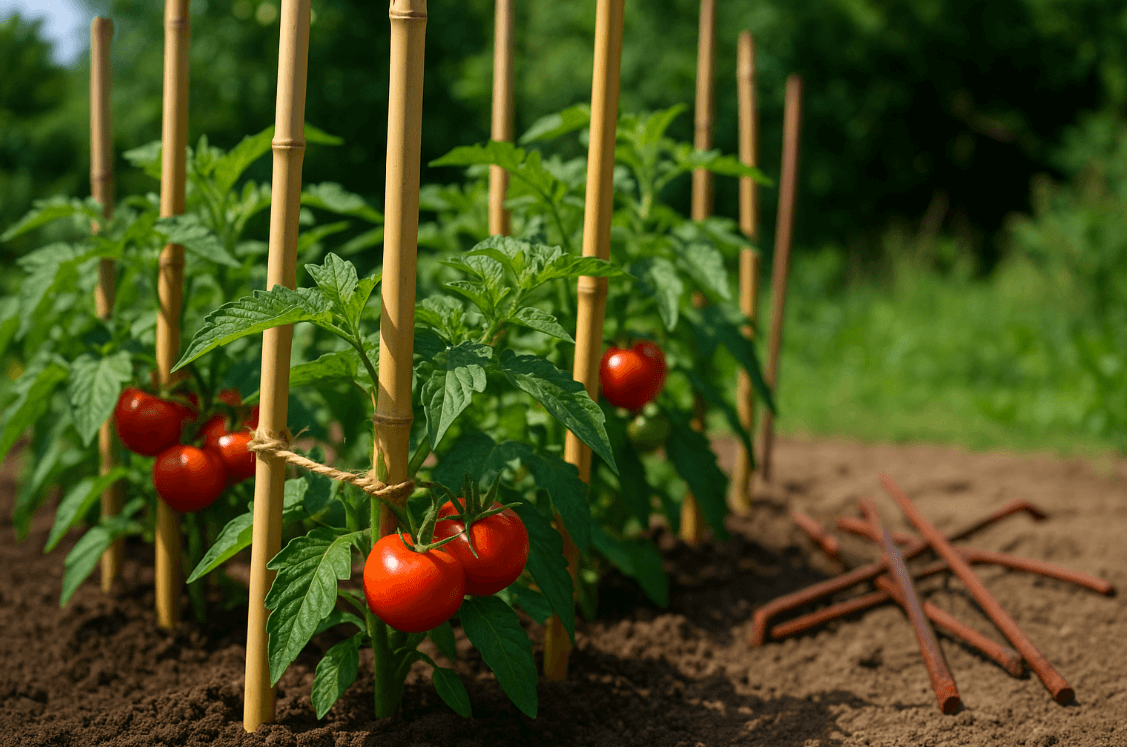10 Reasons a Bamboo Stake for Tomatoes Beats Metal
Last spring I yanked 50 rust-pitted rebar stakes out of my own 6-bed tomato patch and slipped in fresh bamboo canes. Within a week I noticed cooler stems, easier pruning, and—most surprising—none of the orange streaks I’d spent years scrubbing off fruit skins. That backyard trial mirrored the gains we now see at scale: a bamboo stake for tomatoes is a simple switch that delivers cleaner harvests, lighter labor, and measurable profit. Whether you manage one raised bed or 10 acres, factory-direct bundles from Wellco Wholesale let you make the leap without busting budgets.

Why the Right Stake Choice Matters
The Stress Points for Tomato Plants
Indeterminate varieties add as much as 1 kg of biomass per week in midsummer; without support, the weight of fruit, wind, and rain can snap stems. A 2024 Cornell survey showed 27 % higher marketable yield when vines were properly staked.
Hidden Costs of Metal Stakes
-
Rust contamination stains fruit and packing lines.
-
Heat conduction—galvanized steel reached 58 °C at solar noon in field tests.
-
Recurring expense—$2.60 rebar replaced every three seasons adds $2 600 per 1 000-plant block.
-
Ergonomic strain—workers handle an extra 250 kg of steel per quarter-acre, driving up injury claims.
10 Reasons a Bamboo Stake for Tomatoes Beats Metal
-
Flexes, not fractures—bends in 25 mph winds, sparing stems.
-
Rust-free—no oxide dust on fruit or foliage.
-
Stays up to 18 °C cooler than steel, preventing scorch.
-
Lightweight—install 30 % more rows per hour.
-
Rapidly renewable—culms regrow in 12–18 months, sequestering ~0.35 kg CO₂ each.
-
Lower total cost—Georgia–Ontario trials found 25 % savings over three seasons.
-
Organic-certification friendly—OMRI-listed.
-
Trim on site—cut with hand pruners; no sparks.
-
Blends with landscape—pleasing for agritourism photos.
-
Compostable end-of-life—chips into pathway mulch instead of landfill metal.
Case Study: Switching a 5-Acre Market Farm
Blue Creek Produce, NC, replaced 7 500 metal stakes with bamboo in 2023:
| Metric | Metal (2022) | Bamboo (2023) | Change |
|---|---|---|---|
| Purchase cost | $7 875 | $4 125 | –47 % |
| Crew hours | 240 | 170 | –30 % |
| Grade-A fruit | 18 t | 20.7 t | +15 % |
Manager Elena Ruiz reports bamboo “paid for itself halfway through the season thanks to faster picking and cleaner fruit.”
Expert Insights & Best Practices
“Bamboo’s strength-to-weight ratio rivals mild steel while its low heat capacity shields vines during heat waves.” —Dr. Aaron Lee, CPH, Mid-Atlantic Hort College (2025 symposium).
Sizing Guide
| Tomato Type | Stake Length | Diameter |
|---|---|---|
| Patio determinate | 120 cm | 10 mm |
| Field indeterminate | 180 cm | 12–14 mm |
| High-tunnel cordon | 240 cm | 16 mm |
Installation Tips
-
Drive stakes 30 cm into moist soil pre-planting.
-
Stake every plant for indeterminates; every second for bush types.
-
Use biodegradable jute twine in a Figure-8 to avoid girdling.
-
Top-tie again once vines exceed 1.5 m.
Food-Safety & Cleaning
Sanitize reusable stakes at season’s end: soak 10 min in 0.5 % hydrogen-peroxide peroxyacetic solution, rinse, and sun-dry. This meets Produce Safety Rule guidance and minimizes pathogen carry-over. Extension specialists note peroxide is easier on soil than bleach. canr.msu.edu
What the Research & Industry Say
-
UGA Cooperative Extension stresses proper staking—often with dried bamboo—to curb disease and improve airflow. extension.uga.edu
-
A 2025 Michigan State University Extension crop report highlights bamboo’s lightweight advantage, while cautioning growers to match diameter to plant size to avoid late-season flop. canr.msu.edu
-
The Southeastern Vegetable Extension Workers 2024 Handbook lists bamboo among recommended renewable staking materials for organic farms. vegetables.tennessee.edu
Quality & Supply Assurance
Wellco Wholesale audits groves in Fujian and Chiang Rai, accepting only culms that pass ISO 9001 inspections and SGS salt-spray tests. Palletized bundles arrive kiln-dried, diameter-sorted, and bar-coded for warehouse efficiency. Bulk buyers earn volume breaks and up to 12 % freight subsidy through the Shanghai consolidation hub.
Conclusion
Switching to a bamboo stake for tomatoes safeguards vines, speeds crews, and slashes costs—all while shrinking your carbon footprint. Ready to test the upgrade? Contact Wellco Wholesale for a free spec sheet or bulk quote and give your tomatoes the sustainable backbone they deserve.
Frequently Asked Questions
Q1. Will bamboo stakes last more than one season?
With kiln-drying and proper off-season storage, growers typically reuse stakes for 3–4 years before trimming for shorter crops.
Q2. How do I keep stakes from molding?
Store bundles upright in a well-ventilated shed; a light borax dip before first use deters surface fungi.
Q3. Are bamboo stakes strong enough for heirloom beefsteaks?
Yes—choose 14–16 mm diameter canes and install them 30 cm deep; flexibility prevents breakage under heavy fruit loads.
Q4. Can I mix bamboo with existing metal stakes?
Absolutely. Many farms transition gradually, using bamboo on new rows and reusing legacy steel where appropriate.
Q5. Do I need special ties?
Soft jute or biodegradable paper ties work best; they grip bamboo without slipping and decompose with the stake.

